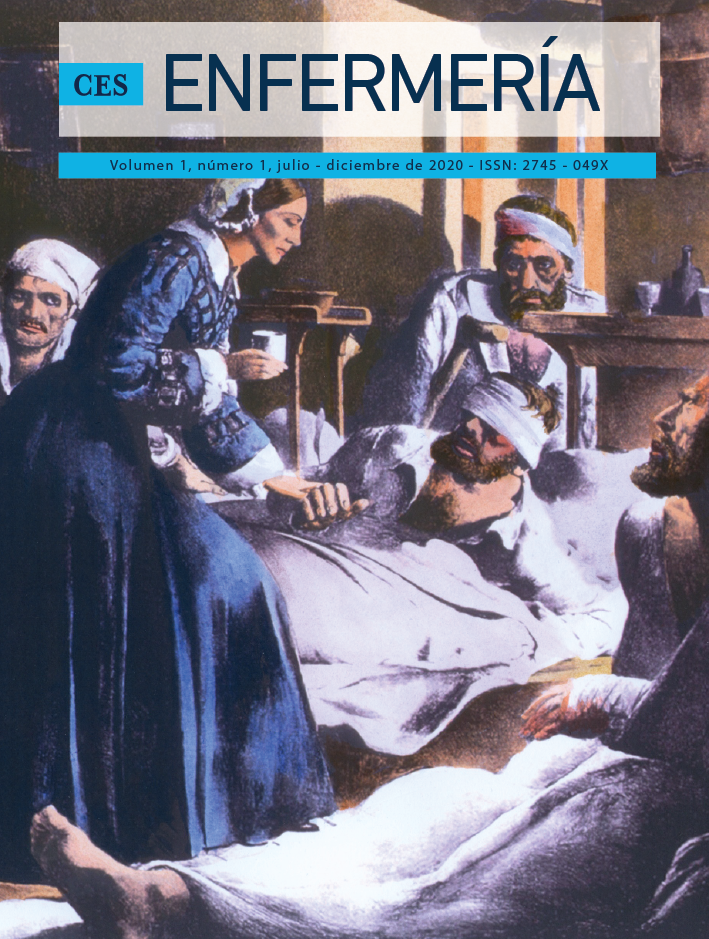Nursing care experience: Patient with respiratory symptoms due to SARS-CoV-2 in an emergency department
Keywords:
Nursing Care, Emergency Service, Coronavirus Infections, HospitalAbstract
Coronavirus disease 2019 causes Severe Acute Respiratory Syndrome Coronavirus 2 (SARS-CoV-2). The infection has a broad spectrum of symptoms such as fever, cough, dyspnea, lymphopenia, and chest imaging findings consistent with pneumonia. Symptom Management Theory proposes nursing interventions to managing symptoms, and reduce their frequency, reduce their severity or alleviate the anxiety associated with them. In this article, we discuss the experience of caring for a patient who consults the emergency department for presenting symptoms related to SARS-CoV-2 infection and dyspnea, asthenia, fever 38.3 ºC, breathing 26 per minute, dry cough and anxiety. He was diagnosed with impaired gas exchange, ineffective breathing patterns, and anxiety. The nursing interventions were respiratory monitoring, oxygen therapy, intubation and stabilization of the airway, management of invasive mechanical ventilation, aid to ventilation, and anxiety reduction. Despite the care provided according to the available evidence, the patient worsened his symptoms, and it was necessary to offer invasive ventilatory support.
Downloads
References
Zhu N, Zhang D, Wang W, Li X, Yang B, Song J, et al. A Novel Coronavirus from Patients with Pneumonia in China, 2019. N Engl J Med [Internet]. 2020 Feb 20;382(8):727–33. Available from: http://www.nejm.org/doi/10.1056/NEJMoa2001017
Wang Y, Wang Y, Chen Y, Qin Q. Unique epidemiological and clinical features of the emerging 2019 novel coronavirus pneumonia (COVID‐19) implicate special control measures. J Med Virol [Internet]. 2020 Jun 29;92(6):568–76. Available from: https://onlinelibrary.wiley.com/doi/abs/10.1002/jmv.25748
Ren L-L, Wang Y-M, Wu Z-Q, Xiang Z-C, Guo L, Xu T, et al. Identification of a novel coronavirus causing severe pneumonia in human. Chin Med J (Engl) [Internet]. 2020 May;133(9):1015–24. Available from: http://journals.lww.com/10.1097/CM9.0000000000000722
Wang D, Hu B, Hu C, Zhu F, Liu X, Zhang J, et al. Clinical Characteristics of 138 Hospitalized Patients With 2019 Novel Coronavirus–Infected Pneumonia in Wuhan, China. JAMA. 2020 Mar;323(11):1061.
Tang X, Du R, Wang R, Cao T, Guan L, Yang C, et al. Comparison of Hospitalized Patients With ARDS Caused by COVID-19 and H1N1. Chest [Internet]. 2020 Jul;158(1):195–205. Available from: https://linkinghub.elsevier.com/retrieve/pii/S0012369220305584
Chan JF-W, Yuan S, Kok K-H, To KK-W, Chu H, Yang J, et al. A familial cluster of pneumonia associated with the 2019 novel coronavirus indicating person-to-person transmission: a study of a family cluster. Lancet [Internet]. 2020 Feb;395(10223):514–23. Available from: https://linkinghub.elsevier.com/retrieve/pii/S0140673620301549
Gralinski LE, Menachery VD. Return of the Coronavirus: 2019-nCoV. Viruses [Internet]. 2020 Jan 24;12(2):135. Available from: https://www.mdpi.com/1999-4915/12/2/135
Huang C, Wang Y, Li X, Ren L, Zhao J, Hu Y, et al. Clinical features of patients infected with 2019 novel coronavirus in Wuhan, China. Lancet [Internet]. 2020 Feb;395(10223):497–506. Available from: https://linkinghub.elsevier.com/retrieve/pii/S0140673620301835
He X, Lau EHY, Wu P, Deng X, Wang J, Hao X, et al. Temporal dynamics in viral shedding and transmissibility of COVID-19. Nat Med [Internet]. 2020 May 15;26(5):672–5. Available from: http://www.nature.com/articles/s41591-020-0869-5
Wei WE, Li Z, Chiew CJ, Yong SE, Toh MP, Lee VJ. Presymptomatic Transmission of SARS-CoV-2 — Singapore, January 23–March 16, 2020. MMWR Morb Mortal Wkly Rep [Internet]. 2020 Apr 10;69(14):411–5. Available from: http://www.cdc.gov/mmwr/volumes/69/wr/mm6914e1.htm?s_cid=mm6914e1_w
van Doremalen N, Bushmaker T, Morris DH, Holbrook MG, Gamble A, Williamson BN, et al. Aerosol and Surface Stability of SARS-CoV-2 as Compared with SARS-CoV-1. N Engl J Med [Internet]. 2020 Apr 16;382(16):1564–7. Available from: http://www.nejm.org/doi/10.1056/NEJMc2004973
Gu J, Han B, Wang J. COVID-19: Gastrointestinal Manifestations and Potential Fecal–Oral Transmission. Gastroenterology [Internet]. 2020 May;158(6):1518–9. Available from: https://linkinghub.elsevier.com/retrieve/pii/S001650852030281X
Ford N, Vitoria M, Rangaraj A, Norris SL, Calmy A, Doherty M. Systematic review of the efficacy and safety of antiretroviral drugs against SARS, MERS or COVID‐19: initial assessment. J Int AIDS Soc [Internet]. 2020 Apr 15;23(4):e25489. Available from: https://onlinelibrary.wiley.com/doi/abs/10.1002/jia2.25489
Vélez M, Vélez V, Marín IC, Castaño D, Velásquez Salazar P, Vera-Giraldo CY, et al. Tratamiento farmacológico de la infección COVID-19 en adultos. Respuesta de 7 días. Unidad de Evidencia y Deliberación para la Toma de Decisiones-UNED Facultad de Medicina, Universidad de Antioquia. 2020.
Jin Y-H, Cai L, Cheng Z-S, Cheng H, Deng T, Fan Y-P, et al. A rapid advice guideline for the diagnosis and treatment of 2019 novel coronavirus (2019-nCoV) infected pneumonia (standard version). Mil Med Res [Internet]. 2020 Dec 6;7(1):4. Available from: https://mmrjournal.biomedcentral.com/articles/10.1186/s40779-020-0233-6
Alhazzani W, Møller MH, Arabi YM, Loeb M, Gong MN, Fan E, et al. Surviving Sepsis Campaign: guidelines on the management of critically ill adults with Coronavirus Disease 2019 (COVID-19). Intensive Care Med [Internet]. 2020 May 28;46(5):854–87. Available from: http://link.springer.com/10.1007/s00134-020-06022-5
Newman MA, Sime AM, Corcoran-Perry SA. The focus of the discipline of nursing. Adv Nurs Sci. 1991;14(1):7–16.
Watson J. Nursing: The Philosophy and Science of Caring, Revised Edition. University Press of Colorado; 2008. 336 p.
Bender M, Janson S, Franck L, Lee KA. Theory of symptom management. In: Smith MJ, Liehr PR, editors. Middle Range Theory for Nursing. Fourth. New York: Springer Publishing Company; 2018. p. 487.
Herdman HT, Kamitsuru S. NANDA International Nursing Diagnoses: Definitions & Classification 2018-2020. Eleventh. Herdman TH, Kamitsuru S mi, editors. New York: NANDA International; 2017. 512 p.
Italian Thoracic Society and Italian Respiratory Society. Managing the Respiratory care of patients with COVID-19 [Internet]. 2020. p. 1–17. Available from: https://ers.app.box.com/s/j09ysr2kdhmkcu1ulm8y8dxnosm6yi0h
Wang C, Pan R, Wan X, Tan Y, Xu L, Ho CS, et al. Immediate Psychological Responses and Associated Factors during the Initial Stage of the 2019 Coronavirus Disease (COVID-19) Epidemic among the General Population in China. Int J Environ Res Public Health [Internet]. 2020 Mar 6;17(5):1729. Available from: https://www.mdpi.com/1660-4601/17/5/1729
Moorhead S, Swanson E, Johnson M, Maas M. Clasificación de Resultados de Enfermería (NOC). Elsevier; 2018. 688 p.
Butcher H, Bulechek G, Dochterman JM, Wagner C. Clasificación de Intervenciones de Enfermería (NIC). Elsevier; 2018. 528 p.
Ppe E. World Health Organization. Rational use of personal protective equipment ( PPE ) for coronavirus disease ( COVID-19 ). 2020.
Gobierno de España. Ministerio de Sanidad. Documento técnico Prevención y control de la infección en el manejo de pacientes con COVID-19. España; 2020.
Barret KE, Barman SM, Brooks HL, Yuan J. Introduction to Pulmonary Structure & Mechanics. In: Weitz M, Boyle PJ, editors. Ganong’s Review of Medical Physiology. Twenty-Six. New York: McGraw-Hill Education; 2019.
Organización Mundial de la Salud. Manejo clínico de la infección respiratoria aguda grave (IRAG) en caso de sospecha de COVID-19. 2020;1–23. Available from: https://apps.who.int/iris/bitstream/handle/10665/330673/9789240000872-spa.pdf
Gattinoni L, Quintel M, Marini JJ. “Less is More” in mechanical ventilation. Intensive Care Med [Internet]. 2020 Apr 11;46(4):780–2. Available from: http://link.springer.com/10.1007/s00134-020-05981-z
Orser BA. Recommendations for Endotracheal Intubation of COVID-19 Patients. Anesth Analg [Internet]. 2020 May;130(5):1109–10. Available from: http://journals.lww.com/10.1213/ANE.0000000000004803
Anesi GL. Coronavirus disease 2019 (COVID-19): Critical care issues [Internet]. UpToDate. 2020 [cited 2020 May 6]. Available from: https://www.uptodate.com/contents/coronavirus-disease-2019-covid-19-critical-care-issues?sectionName= VENTILATOR MANAGEMENT OF ACUTE RESPIRATORY DISTRESS SYNDROME &topicRef=127481&anchor=H312768942&source=see_link
Elsevier Order Set. Covid-19 - emergency department(4.0) [Internet]. 2020 [cited 2020 May 5]. Available from: https://covid-19.elsevier.health/en-US/resources/emergency-department#what-to-know
Centers for Disease Control and Prevention. Coronavirus Disease 2019 (COVID-19). Management of Visitors to Healthcare Facilities in the Context of COVID-19: Non-US Healthcare Settings [Internet]. 2020 [cited 2020 May 8]. Available from: https://www.cdc.gov/coronavirus/2019-ncov/hcp/non-us-settings/hcf-visitors.html
Rajkumar RP. COVID-19 and mental health: A review of the existing literature. Asian J Psychiatr [Internet]. 2020 Aug;52(January):102066. Available from: https://linkinghub.elsevier.com/retrieve/pii/S1876201820301775
Rushton C. Nurses face “unprecedent challenges” during Covid-19. Futurity. 2020.
Downloads
Published
How to Cite
Issue
Section
License
Copyright (c) 2020 CES Enfermería

This work is licensed under a Creative Commons Attribution-NonCommercial-ShareAlike 4.0 International License.
| Article metrics | |
|---|---|
| Abstract views | |
| Galley vies | |
| PDF Views | |
| HTML views | |
| Other views | |



